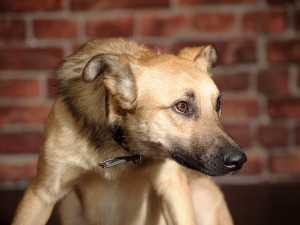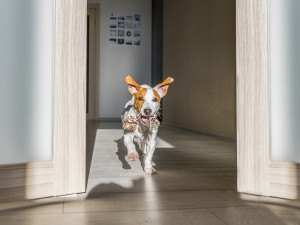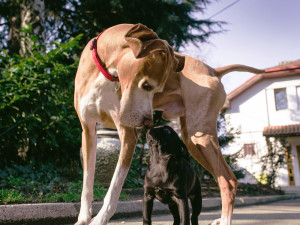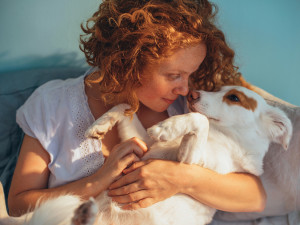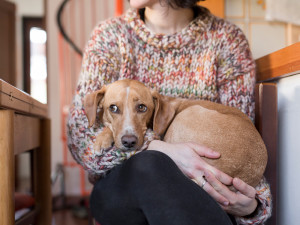9 Reasons Why Dogs Put Their Ears Back
Here’s how your dog’s ears can clue you in to how they’re feeling.
In This Article:
Why Do Dogs Pull Their Ears Back? What Your Dog’s Pinned-Back Ears Mean How Else to Understand Dog Expressions and Body Language?
If you can wiggle your ears, you have a unique talent that only around ten percent of humans possess. And while most humans can’t literally perk their ears up for anything, dogs can and do move their ears frequently and for many different reasons. Their ears provide complex messaging too. This is because similar positions can have multiple meanings, depending on the context and their other body language.
Why do dogs pull their ears back?
Did you know that dogs have about three times more muscles in their ears than we do? If you really study your dog’s ears, you’ll notice they are almost constantly moving. Dogs utilize their beefed-up ear muscles for many important roles. Primarily, they use them to improve their hearing by moving their ears in the direction of sounds. They also move their ears to communicate with other dogs.
How much do you spend on your pet per year?
Depending on the breed and ear conformation, a dog may be able to make their ears stand straight up on top of their head and/or pull them back to varying degrees. You’ll have to look at all the other signals from your dog to get the best read on what’s going on and to understand why your dog pulls their ears back in different situations.
What your dog’s pinned-back ears could mean
Different emotions and needs may be tied to their ear positions, including:
Fear
Fearfulnessopens in new tab is often communicated by ears that are pulled back. This is especially true if combined with other body language such as a hunched body posture, tucked tail, and/or avoiding eye contact. Other signs of fear include physical changes like panting or breathing quickly, dilated pupils, shaking, yawning frequently, and/or vocalizing.
Sadness
Sadness can also be expressed partly by ear position. Many pet parents report anecdotally that their dogs experience feelings similar to sadness and/or depression if they lose a companion or even if they are asked to do something they don’t want to do. It may be intertwined with feelings like anxiety or fear and can also result in ears that are pulled close to the head.
Anxiety
Anxious behaviors may include ears that are pulled back along with other signs of stress like panting, looking away, yawning frequently, whining, licking their lips and/or acting restless. Some dogs have specific anxieties such as storms, fireworks, or trips to the vet, while other dogs may be generally anxious and show signs in lots of different situations.
Appeasement in greetings
When dogs approach each other or initiate play, they may put their ears back, though in this context they usually just pull their ears back slightly. This is considered an appeasement behavior meant to reassure the other dog that they mean no harm. The rest of their body language should confirm this with signs such as a loose, wiggly body, friendly tail wag, and/or play bows.
Danger and/or aggression
Dogs that feel especially scared, threatened, or aggressive often show very dramatic body language. This can include ears that are pulled very far back so they are nearly flat against the head. They often will be growling with very stiff body posture, hard-barking, staring, and/or lunging. This is a clear message to back off and beware.
Courting
A male dog may display a number of behaviors aimed at seeking a female dog’s interest. This can include pulling his ears back as he approaches her. It may overlap with appeasement gestures as another sign that he’s not a threat to the female dog.
Pain from injury or otherwise feeling unwell
When dogs are generally sick or in pain, they may also hold their ears back. This may be due to fear and anxiety related to being in pain and they will likely show other signs of pain, too.
Listening
Dogs frequently move their ears to maximize hearing. Think of their outer ear as a big funnel which helps to capture and concentrate sounds. By moving their ears in the direction of the sound, they are able to amplify faint sounds that may be far away too.
Natural position
For some dogs, their ears naturally rest in a pulled back position. This can be breed-related or due to certain injuries that cause scarring or deform the natural shape of the ear. For example, aural hematomas can damage the shape of their ears making them look more pulled back or shriveled as well.
How else can I understand my dog’s expressions and body language?
A dog’s whole body is communicating information about their emotional state and a dog’s ear position is just one small part of the whole puzzle. Understanding dog body language is complex and it can take time to learn all of the subtle cues dogs use to express themselves.
In addition to body language, dogs also communicate with scents and vocalizations, so it is important to factor these in as well. When studying your dog’s body language, it may be helpful to break it down into different sections of their body.
Overall body position: Note your dog’s posture and level of tension in their muscles. Is your dog tense and still? This can be a sign that they are on guard, feeling scared, and/or threatened. A loose, wiggly body is a sign they are comfortable and ready to play. Is their posture hunched, cowering, or upright? Is their hair standing up on end, making them look puffed up and intimidating? These general body positions can be a good indicator of how your pup is feeling.
Eyes: A hard, direct stare is a sign of aggression and may be a warning before a bite occurs.
Wide eyes with the white part of the eye showing, known as a “whale eye,” and large, dilated pupils are both signs of fear and anxiety. Dogs that are avoiding eye contact and/or looking down are also showing signs of fear.
Mouth: A dog with a slightly opened, relaxed mouth is usually at ease. A dog with a tightly closed mouth or a mouth pulled back in a grimace may be feeling afraid. Lip licking and/or yawning can indicate anxiety. A dog who is baring their teeth is warning those around them that they feel threatened and may be ready to bite.
Tail: The tail is well-known as a mood indicator, but humans often get the message wrong. Tail wags can mean different things from friendliness to aggression depending on the subtle changes in how they are wagging. A circular wag and loose body is usually a sign of friendliness, while a tail that is waving like a flag with a rigid upright position and just a small wave of the tip often indicates a high level of arousal and/ aggression. A tucked tail is usually associated with fear and/or anxiety.
Bottom line
Dogs communicate tons of information through their body language, including their ear positions.
Humans often need practice in understanding and interpreting dog body language.
When a dog’s ears are pulled back, it can mean many different things. It is very important to look at the full picture including all of their body language and the context of the situation.
FAQs
Why is it important to understand your dog’s ear positions?
Understanding your dog’s ear positions helps you to know how your dog is feeling. It can deepen your bond with them and enhance your dog’s ability to communicate with you. It also offers insights into how they might behave if you approach them, and may help you identify when to intervene to avoid dangerous situations.
Should I use caution when approaching a dog with their ears held back?
Ears pulled back can mean so many things, so it is important to look for other clues in their body language and in the situation. Be cautious if you notice other signs that may indicate pain, fear, and/or aggression.
What does it mean if my dog has one ear up and one ear down?
One ear up and one ear down is the universal signal of extreme cuteness in dogs, but is not associated with any particular mood or emotion. Often, one ear has stronger cartilage or muscles, which may be more common in puppies than in adult dogs. This asymmetry could also signal an injury to that ear.
What does it mean if dog ears are folded?
Dog ears folded back are just temporarily stuck that way, and there is no emotional message associated with it. A quick shake or a helping hand from their human can revert a folded ear to its normal position.
References
Boneh-Shitrit, Tali, et al. “Explainable Automated Recognition of Emotional States from Canine Facial Expressions: The Case of Positive Anticipation and Frustration.” Scientific Reports, vol. 12, no. 1, 30 Dec. 2022, p. 22611, www.nature.com/articles/s41598-022-27079-wopens in new tab, https://doi.org/10.1038/s41598-022-27079-wopens in new tab.
Bremhorst, A., et al. “Evaluating the Accuracy of Facial Expressions as Emotion Indicators across Contexts in Dogs.” Animal Cognition, 2 Aug. 2021, https://doi.org/10.1007/s10071-021-01532-1opens in new tab.
Gähwiler, Sarah, et al. “Fear Expressions of Dogs during New Year Fireworks: A Video Analysis.” Scientific Reports, vol. 10, no. 1, 29 Sept. 2020, www.nature.com/articles/s41598-020-72841-7.pdfopens in new tab, https://doi.org/10.1038/s41598-020-72841-7opens in new tab.
Hasegawa, Masashi, et al. “Dogs’ Body Language Relevant to Learning Achievement.” Animals, vol. 4, no. 1, 27 Feb. 2014, pp. 45–58, https://doi.org/10.3390/ani4010045opens in new tab. Accessed 11 Aug. 2019.
Mota-Rojas, Daniel, et al. “Current Advances in Assessment of Dog’s Emotions, Facial Expressions, and Their Use for Clinical Recognition of Pain.” Animals, vol. 11, no. 11, 22 Nov. 2021, p. 3334, https://doi.org/10.3390/ani11113334opens in new tab.
Walsh, Elizabeth Ann, et al. “Human-Dog Communication: How Body Language and Non-Verbal Cues Are Key to Clarity in Dog Directed Play, Petting and Hugging Behaviour by Humans.” Applied Animal Behaviour Science, vol. 272, 23 Feb. 2024, p. 106206, www.sciencedirect.com/science/article/pii/S0168159124000546opens in new tab, https://doi.org/10.1016/j.applanim.2024.106206opens in new tab.



